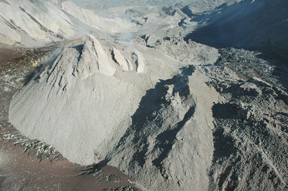|
News Notes
Volcanoes
Crystals heat up volcanic eruptions
 Starting in March 1980, earthquakes, steam and a bulging side indicated that Mount St. Helens was waking up, but volcanologists had only a vague idea about the mechanics of the magma miles below the mountain that eventually led to its deadly May 18 eruption that year. Now, key pressure and temperature information preserved inside tiny bubbles in lava is causing scientists to rethink previous assumptions about how magma behaves, and what might trigger eruptions.
Starting in March 1980, earthquakes, steam and a bulging side indicated that Mount St. Helens was waking up, but volcanologists had only a vague idea about the mechanics of the magma miles below the mountain that eventually led to its deadly May 18 eruption that year. Now, key pressure and temperature information preserved inside tiny bubbles in lava is causing scientists to rethink previous assumptions about how magma behaves, and what might trigger eruptions.
Crystals inside lava from Mount St. Helens, shown here in September, helped researchers learn about how the temperature of magma changes during an eruption. Photograph is by Willie Scott.
Volcanologists can only learn about what happens inside a volcano through indirect observation, such as by studying the composition of lava that has already made its way to Earth’s surface. Inside such volcanic rocks, scientists observe tiny, bubble-like textures. Previously, the textures have most often been attributed to occurrences of magma mixing deep inside the volcano, by which one type of magma flows into a chamber and mingles with a different type. Magma mixing can affect how, and possibly if, a volcano will erupt.
Magma mixing, however, is not the entire answer to the question of how volcanoes erupt, according to Jon Blundy, a petrologist at the University of Bristol in the United Kingdom, and colleagues. Publishing in the Sept. 7 Nature, the team describes a new contributing factor: heat expelled by the formation of crystals.
Scientists have long known that when a crystal forms, it emits heat. “That sounds odd to a lot of people,” says Kathy Cashman, a volcanologist at the University of Oregon in Eugene. “But the inverse is easy to understand,” she says, citing a jar of honey that has crystallized: To deconstruct, or melt, the crystals requires that heat be added, such as from a microwave. So, to construct a crystal requires that it cool, or emit some of its heat. Volcanoes, however, are anything but cool, making the presence of crystal structures in magma “counterintuitive” to some geologists.
In a previous study, Cashman and Blundy found that crystals form not from cooling temperatures, but as the result of a drop in pressure as the magma chugs to the surface, forcing it to cool itself by emitting heat, Cashman says. With the link between pressure and crystal formation established, the team wanted to take that research a step further and see if they could determine the magma’s temperature.
First, the team looked to existing research that has shown that measurable data for water content, melt level, crystal growth and temperature exists inside tiny bubbles inside the crystals, and that all variables are related. Having measured the first three variables from lava erupted from Mount St. Helens and from Shiveluch volcano in Kamchatka, the team could chart how temperature had changed inside the magma as it made its way to Earth’s surface.
The team noticed that crystals growing in the magma early, well before erupting, were associated with lower temperatures, while crystals growing closer to the time of eruption recorded high temperatures. “That allowed us to really show demonstrably that the magma was heating up as it got toward the surface,” Cashman says. So, as magma rises inside the volcano, the team says, it depressurizes, which forces crystals to grow. That, in turn, produces heat, increasing the magma’s temperature by as much as 100 degrees Celsius.
The finding “might make us look a lot harder [at inclusions] before we jump to the conclusion that we’ve actually seen magma mixing,” says Cynthia Gardner, a volcanologist with the U.S. Geological Survey’s Cascades Volcano Observatory in Vancouver, Wash. The distinction is crucial because magma mixing “is a very important phenomenon,” Gardner says, and in some cases it might be responsible for triggering volcanic events. The exact trigger mechanism is still an open question, however, as heat from crystallization might also contribute, she says.
For monitoring, however, the predictive capability of the heating process is not quite there yet, Gardner says. Without probes to record real-time information inside the volcano, researchers are “stuck with what reaches the surface” after the volcano erupts.
Now that scientists know the process of crystal-induced heating is likely occurring, however, they will begin to think about how to develop new sensors, she says, or some entirely new way to monitor eruptions. And that could come in handy for people living in the vicinity of Mount St. Helens and Shiveluch — one of the largest and most active volcanoes on the Kamchatka Peninsula.
Kathryn Hansen

 Subscribe
Subscribe

